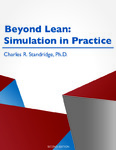Please use this identifier to cite or link to this item:
http://lib.hpu.edu.vn/handle/123456789/21529Full metadata record
| DC Field | Value | Language |
|---|---|---|
| dc.contributor.author | Standridge, Charles | en_US |
| dc.date.accessioned | 2016-06-18T01:53:33Z | |
| dc.date.available | 2016-06-18T01:53:33Z | |
| dc.date.issued | 2013 | en_US |
| dc.identifier.other | HPU3160190 | en_US |
| dc.identifier.uri | https://lib.hpu.edu.vn/handle/123456789/21529 | - |
| dc.description.abstract | This book discusses how, in a practical way, to overcome the limitations of the lean approach to transforming manufacturing systems as well as related in-plant, plant-to-plant, and plant-tocustomer logistics. The primary tools in this regard are algebra based mathematical models and computer-based systems simulation as well as the integration of these two. Concepts, methods, and application studies related to designing and operating such systems are presented. Emphasis is on learning how to effectively make design, planning, and operations decisions by using a model based analysis and synthesis process. This process places equal emphasis on building models and performing analyses. This first part of the book discusses this process as well as the methods required for performing each of its steps. The beyond lean approach is introduced in chapter 1 and illustrated with an industrial application. One proven process for performing a beyond lean study is presented. Some principles that guide such studies are discussed. Methods are considered in chapters 2 through 5: model building, the computations needed to simulate a model and experimentation with models as well as modeling time delays and other random quantities. The basic logic used in simulation models is discussed. A process by which a distribution function can be selected to represent a random quantity, in the presence or absence of data, is given. An overview of the internal operations of a simulation engine is presented. Chapter 2 describes the most basic ways in which systems are represented in simulation models. These basic ways provide a foundation for the models that are presented in the application study chapters. The modeling of common system components: arrivals, operations, routing, batching, and inventories, is discussed. Chapter 3 presents a discussion of how to choose a distribution function to characterize the time between arrivals, processing times, and other system components that are modeled as random variables. A computer based interactive procedure for fitting a distribution function to data is emphasized. A discussion of selecting a distribution function in the absence of data is presented. Chapter 4 presents the design and analysis of simulation experiments. Model and experiment verification and validation are included. An approach to specifying simulation experiments is discussed. Methods, including statistical analyses, for examining simulation results are included. An overview of animation is given. Chapter 5 discusses the unseen work of a simulation engine in performing the computations necessary to simulate a model on a computer. Topics include the following: random number stream generation, random sampling from probability distribution functions, performance measure computation, event and entity list management, and state event detection. | en_US |
| dc.format.extent | 323 p. | en_US |
| dc.format.mimetype | application/pdf | - |
| dc.language.iso | en | en_US |
| dc.publisher | Grand Valley State University | en_US |
| dc.subject | Business | en_US |
| dc.subject | Management | en_US |
| dc.subject | Marketing | en_US |
| dc.subject | Practice | en_US |
| dc.title | Bayond lean: Simulation in practice | en_US |
| dc.type | Book | en_US |
| dc.size | 5,814KB | en_US |
| dc.department | Education | en_US |
| Appears in Collections: | Education | |
Files in This Item:
| File | Description | Size | Format | |
|---|---|---|---|---|
| 08_BayondleanSimulationinpractice.pdf Restricted Access | 5.81 MB | Adobe PDF |  View/Open Request a copy |
Items in DSpace are protected by copyright, with all rights reserved, unless otherwise indicated.
